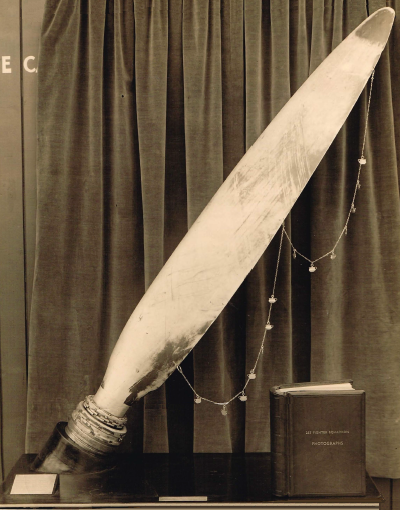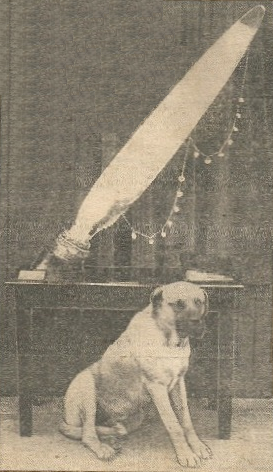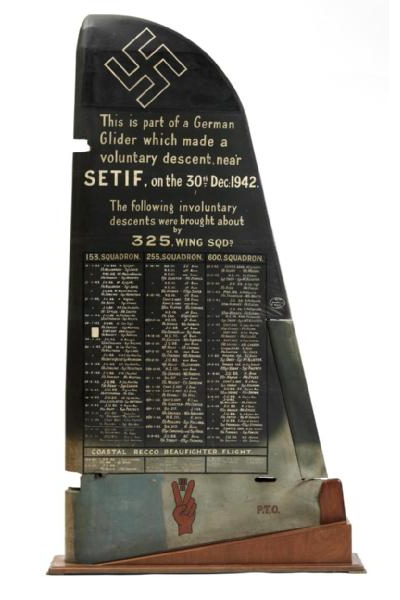 |
 |
Left: The Chain, propeller and oak base photographed at RAF Coltishall December 1941. |
|
 |
 |
Left: The Chain, propeller and oak base photographed at RAF Coltishall December 1941. |
|
Our CO then had made, from a single propeller blade and silver, model ‘jerries’ (chamber pots) which hung from it by a silver chain. All this was attached to a wooden base. Each silver ‘jerry’ had the squadron pilot’s name, a/c, and date on which a German aircraft was destroyed thereon. Unsurprisingly, I have never found anyone who knew what happened to this unique memorial and wonder if anyone can supply the answer. One of my interests in it is because, in August of 1941, S/L (then) Johnny Bartlett gave me the job, when I was squadron gunnery officer, of having his idea created with the help of a well-known London jewellers! After I had been posted to another unit, 255 squadron went, in a year or more, to the Middle East, so it may have ended up there.[5]Subsequent correspondence and a transatlantic telephone conversation with Michael before his death revealed that the well-known London jewellers were none other than Asprey of New Bond Street, but a search there for records of the chain’s creation proved unproductive. For decades the Royal Jewellers had recorded every transaction made, but their archive was destroyed in the Blitz and the routine had not resumed.
There, in a tiny villa handed over, willingly enough, by the Mayor, 255 squadron had its Mess; sleeping quarters were in tents outside the village.... In the Mess – in England a place of austere luxury but in Africa a tiny stone-walled room that was home-like in its comfort – stood against the wall the twisted metal of a propeller that had once driven a German aircraft through the skies.... From its tip hung a silver chain, and, at intervals, there were linked little metal plaques fashioned in the shape of a tiny replica of a useful domestic utensil. On each was engraved the names of the pilot and observer and the date of the kill.... Many more Jerries were to be added to the chain in the weeks to come.[6]Strangely, neither volume of Wynne-Willson’s two-part autobiography mentions the chain, nor does the Squadron ORB. But the photographic evidence, the newspaper reports from mid-August 1942, the creator’s research request posted on rafweb.org and the reference in Wing Commander Wisdom’s book Triumph over Tunisia can leave little doubt that the artefact existed and moved with the Squadron from Kirton to Hibaldstow to Coltishall to High Ercall to Honiley and thence to Algeria, all the while collecting further chamber pots as it went. Fairly obviously it was regarded as the property of the Officers Mess rather than the property of any one individual; by the time the squadron moved to Algeria the chain’s original creators were either dead (Johnny Bartlett DFC, having been promoted to Wing Commander, was killed 22 August 1941[7]) or serving elsewhere.
 |
This trophy was made from part of the tailfin of a German Deutsche Forschungsanstalt für Segelflug DFS 230 assault glider, found abandoned in Algeria between Sétif and Philippeville at the end of December 1942. 325 Wing records suggest that the date was 30 December and the place St.Arnaud[8]. The glider is presumed to have been involved in some behind-the-lines activity by airborne troops of the Wehrmacht. Both sides of the tailfin are painted with a record of confirmed 'kills' achieved by the squadrons and flights of No.325 Wing, of which No.255 Squadron was at the time a part. The record of 255’s successes overflows onto "side two" but is nevertheless incomplete. Entries were backdated to include their first North African success on the night of 05-06 December 1942, but updating of this trophy ceased before 255 left North Africa for Sicily. There is a partial overlap with the record commemorated on the Chain of Jerries. The tailfin survived the war and has been preserved by the Imperial War Museum[9]. Currently (2016), it is on public display at IWM North, Manchester. |
|
| 1. ^ | Example: Birmingham Post, AM edition of Wednesday 12 August 1942, p.3. Note that the accompanying article is separated from the image and appears on page 4. |
| 2. ^ | TNA : AIR50/98/42 and AIR50/98/43. Both available online, as individual documents. |
| 3. ^ | TNA : AIR27/1518 folio 8 side 2. |
| 4. ^ | TNA : AIR27/1518 folio 58 side 2. |
| 5. ^ | Research request No.587 on the website rafweb.org, dated 9 August 2008, posted online by Michael Wynne-Willson. |
| 6. ^ | Wisdom, T.H. (1944). Triumph over Tunisia. London : George Allen & Unwin, p.112–113. Predates ISBN catalogue system. |
| 7. ^ | Buried at Brookwood Military Cemetery. |
| 8. ^ | 325 Wing documentation gives the location as St.Arnaud, which has since been re-named El-Eulma. See AIR26/433 (+date), a volume bound with some pages in the wrong order. Original document – requires TNA Readers Ticket to view. |
| 9. ^ | IWM catalogue number EPH 7425. |